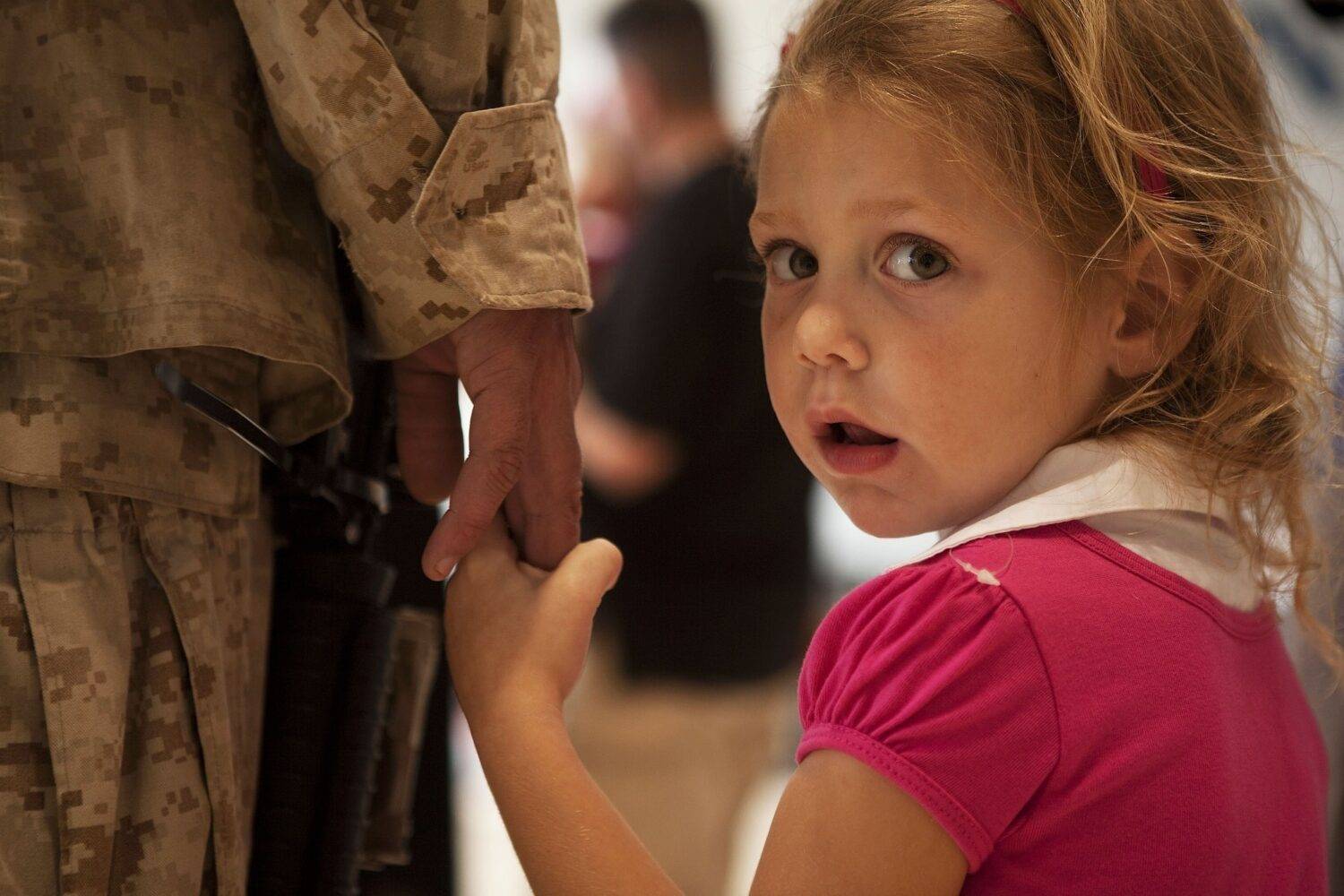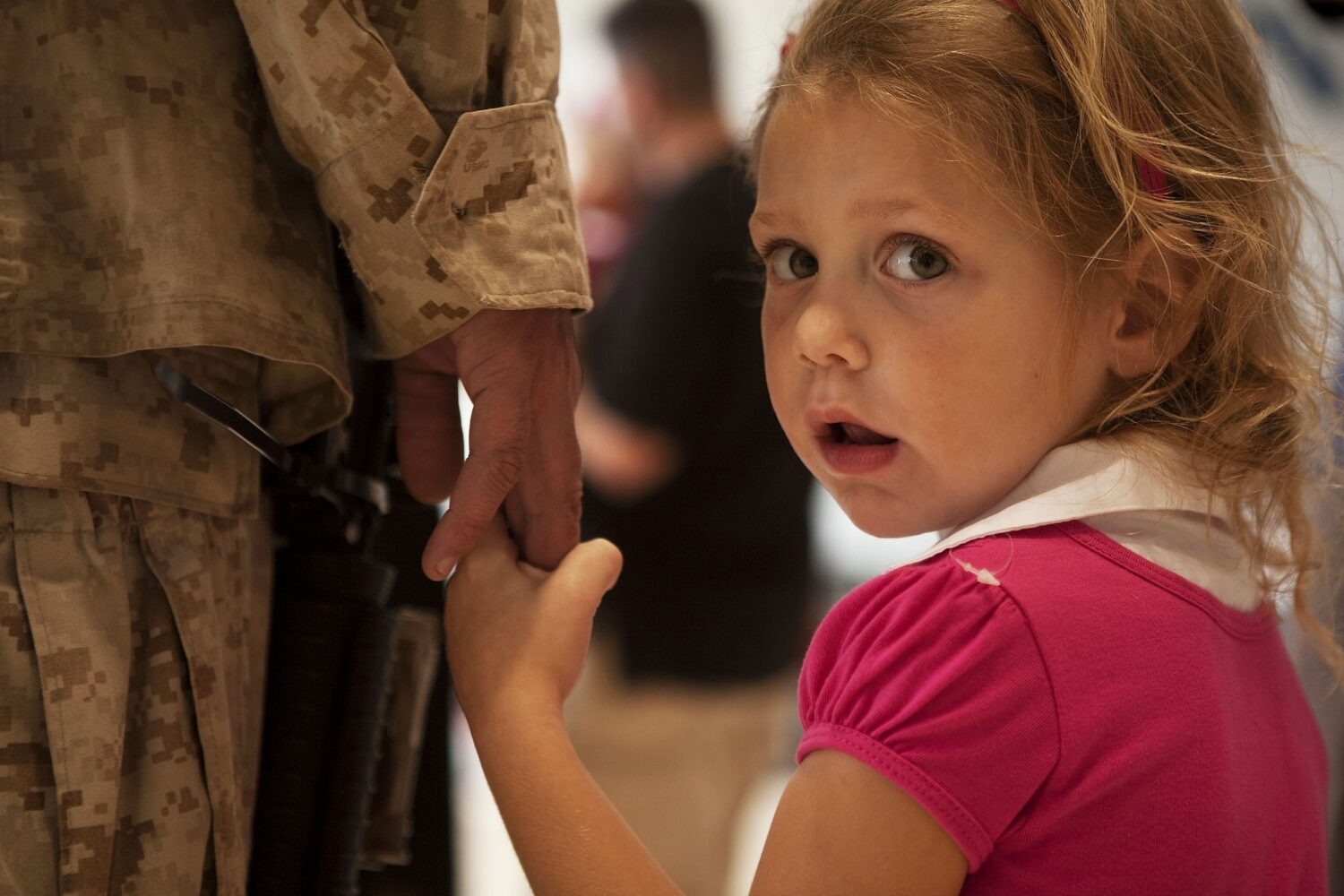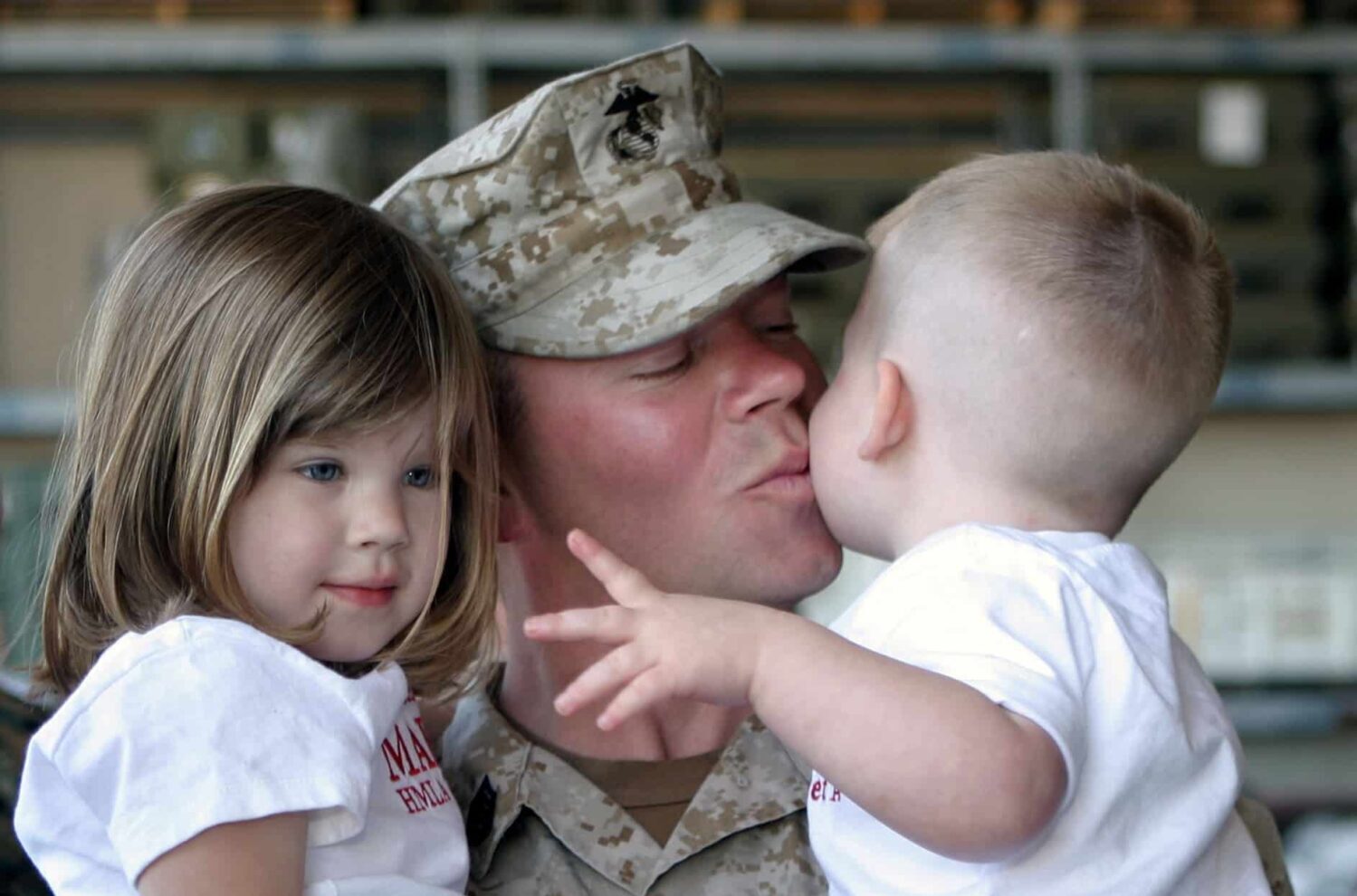Children and war: Loss, family stress, and attachment relationships

The formation of a secure attachment between a caregiver and a child provides the foundation for resiliency and healthy coping strategies during stressful times. Disruptions to these early attachment relationships leave a child vulnerable.
A consistent theme in family adaptation is the family’s ability to make sense of their experience. When a caregiver is away at war, the stress on the family is immediate and can have lasting effects, especially on very young children.
Family Stress
Families of service members deployed to war are forced to live with both the hope and expectation of a safe return and the acute awareness of possible loss of life. During times of war, risk varies for different family members and different family systems.
“When a caregiver is away at war, the stress on the family is immediate and can have lasting effects, especially on very young children.”
Stressful life events and normative life events before notification of deployment, during separation, and after reunion contribute to the overall adaptation of the family. Individuals who have strong connections to family and community support and can identify and use these supports adapt to the changes and continue to thrive after deployment. For others, the cumulative and chronic nature of stressors on their family system increases uncertainty about individual and family well-being.
Infants and toddlers also experience separation and loss, but their needs can be overlooked when caring adults are overwhelmed and assume that children will not remember this time. Yet the young are the most vulnerable. Separation during deployment affects an infant’s attachment relationship with the service member. Boundary ambiguity about who is in or out of the family, as well as both visible and invisible wounds of war, represent other losses in the parent-child relationship.
Injuries sustained in war may be visible or invisible to children. Invisible injuries are more difficult for children to understand because there are no obvious physical signs. Invisible injuries such as post-traumatic stress syndrome (PTSD), traumatic brain injury, and depression can harm the quality of the parent-child relationship because these wounds often are associated with parental irritability, rapid mood swings, emotional numbing, memory loss, and lack of behavior control. Any of these can enhance children’s risk for disorganized attachment, psychological distress, emotion and behavior dysregulation, and poor health and well-being.
Children growing up in homes with a depressed parent are at increased risk for depression themselves, as are children raised by parents with substance abuse disorders, especially when they occur with high levels of aggression and violence. Children traumatized by parental violence may themselves develop symptoms of PTSD.

Photo: PxHere.
The nature of the invisible injury may directly harm family functioning and the quality of parent-child relationships necessary for promoting optimal child development. While all types of parental combat injuries influence various components of family functioning, evidence suggests that families are more resilient when there are visible wounds and struggle more with changes related to invisible ones.
Ambiguous Loss
The realities of stress on non-deployed parents can make it difficult for them to be emotionally present with their child during and after deployment. Uncertainty about the extent of the loss and the inability to bring closure to these losses make them ambiguous.
Psychologists describe two types of ambiguous loss: when a loved one is physically absent but psychologically present, and when a loved one is physically present but psychologically absent.
The concept of ambiguous loss became significant when research with families of U.S. military sent to fight in the Vietnam War looked at the psychological presence of a father declared missing in action.
Studies showed that the effect of the father’s absence was influenced by the mother’s adjustment in the first few years after receiving notification of the father’s missing-in-action status. Later studies revealed that ambiguous loss during a parent’s deployment changed not only children’s relationship with the deployed parent but also their relationship with the non-deployed parent.
During Deployment
Certainly, both deployed parents and children at home experience the loss of shared developmental milestones (e.g., first smile, step, word). Lengthy separations are thought to have greater implications for young children, who are developmentally unable to process the cause of the separation, time of the parent’s absence, or explanations of the parent’s return.
When the service member is absent, the non-deployed caregiver and that caregiver’s attunement to the developmental milestones of the child or the impact of stressors on the young child are critical for normal attachment and development of young children.
“Infants and toddlers also experience separation and loss, but their needs can be overlooked when caring adults are overwhelmed.”
Ongoing fear for the loved one’s safety and a fixation on the war can result in the non-deployed parent or caregiver being psychologically absent during the deployment. While they are physically present, they may be unable to maintain normal routines or care for children. For these adults, feelings of despair can lead to ambivalence, guilt, anxiety, depression, and incapacitation.
Boundary ambiguity about who is in or out of the family unit or what roles individuals play in a family can be conceptualized on a continuum with varying degrees of psychological presence or absence, as well as changing physical presence or absence. When a parent is deployed or absent from the home for an extended period, other family members assume their roles within the family and may not be interested in relinquishing some of those responsibilities when the service member returns.
Reunion
Community supports in place during deployment might assume that once the service member is home, life will quickly return to normal. However, when service members return, they have to deal with not only their wartime experiences but also the loss of family as they knew it prior to their deployment. Many become acutely aware of developmental milestones missed and the ability of the family to go on without them. As the boundaries of who is in or out of the family change and the future seems uncertain, families may experience turmoil. Building an attachment relationship is influenced by parents’ ability to be both physically and psychologically present for their child during all phases of the deployment cycle, including the reunion and reintegration of family.

Photo: PxHere.
Military families and community support need to understand and normalize bodily responses to chronic stress and how these responses create ambiguity. The stress response that activated to help the service member or at-home caregiver survive their stressful experience takes a toll on the human body. Over time, the endemic stress affects bodily functions like heart rate, blood pressure, immunity, sleep, attention, and moods.
Furthermore, thinking about negative events that happened in the past or fearing for the future can continue to hijack the stress response, making it more difficult to manage everyday relationships. When parents are consumed with thoughts and fears, they are unable to be present and attuned to their child in the moment, that is, they might be physically present but psychologically absent. This can happen at any stage of the deployment cycle.
Family Functioning
When parents experience stress that takes them away from being attuned to and present with their children, there is strength is seeking help from professionals. Meaningful treatment focused on the injury, role changes, and loss of personal and family dreams is central in the process of healing.
A multi-level, systemic, resilience-building approach is needed to strengthen family and community resources, rather than focusing solely on individual deficits. Considering parents’ combat injuries, interventions should respect individual, family, military, and community differences. Having strong social support facilitates better adjustment for the injured and has a buffering effect on the family. When social supports reduce the stress experienced by the military family, the parent can focus on being emotionally responsive and attuned to the needs of their child.
“When service members return, they have to deal with not only their wartime experiences but also the loss of family as they knew it prior to their deployment.”
The early life trajectory is shaped largely by infants’ relational world of family, community, and life contexts. During times of stress, parents can provide comfort and security for their children by establishing and maintaining routines. Age-appropriate tasks may help children feel that they are contributing positively to the family.
Children need to make sense of what the stress means for their life. When adults communicate age-appropriate information, it supports children’s intuitive sense that something is wrong. Parents can also create an environment where the child knows it is acceptable to ask questions. What children want and need to know changes as they grow. Children express a broad range of emotions, and they often need their caregivers to help them name and regulate their emotions.
Child development studies consistently promote the benefits of children maintaining a relationship with both parents. Children need the adults in their life to plan activities and rituals that help them feel connected to a parent who is physically absent.
During wartime deployments, events inevitably occur outside families’ control. Family members’ beliefs, values, goals, and perceptions of themselves in the context of their community may influence whether the family views their situation as manageable. Community supports can focus on reducing parental stress, mitigating mental health challenges, building confidence in parents’ engagement, and supporting strategies that enable parents to live in ways that are consistent with their values.
The post Children and war: Loss, family stress, and attachment relationships appeared first on Child and Family Blog.
















Leave a comment